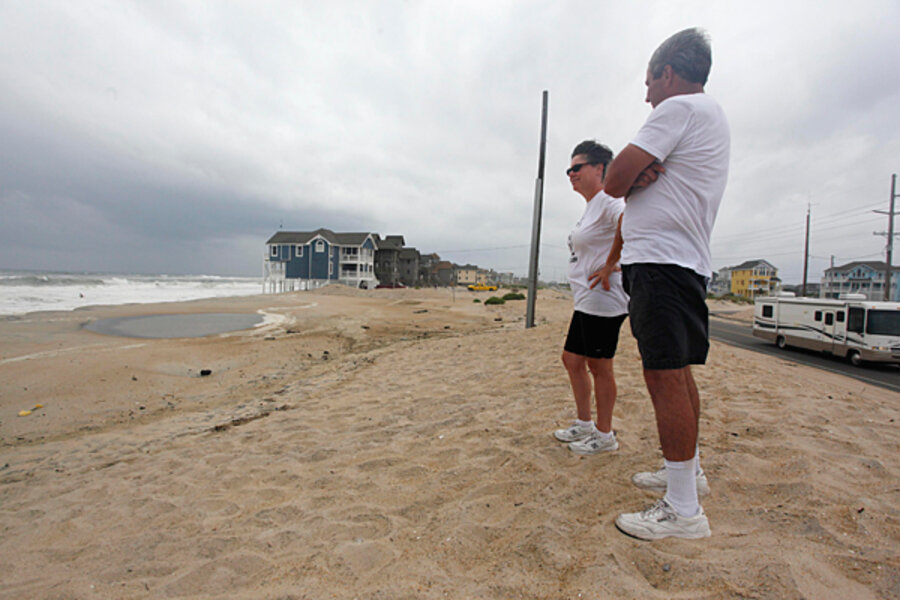Hurricane Earl path stretches from North Carolina to Boston Harbor
Loading...
Hurricane Earl, some 300 miles south of North Carolina's Cape Hatteras, has now prompted tropical-storm or hurricane warnings from the Tar Heel State's coast to the Massachusetts-New Hampshire border.
Coastal New England from Westport, Mass., to Hull, a town at the end of a peninsula forming part of Boston Harbor, is the latest swath of coastline to come under a hurricane warning.
From the North Carolina-Virgina border up to Westport, the entire coastline is under a tropical storm warning. The Delmarva Peninsula is under a hurricane watch as well.
"We've talked about people needing to be prepared and getting their plans ready. We're past that," says Craig Fugate, director of the Federal Emergency Management Agency (FEMA). "This is a day of action." People need "to be ready to heed any additional evacuation orders as this storm continues to track to the north," he says.
The storm continues to pack maximum sustained winds of 140 miles per hour and is working its way toward the coast at about 18 m.p.h.
Track forecasts for hurricane Earl have been holding up pretty well, according to Bill Read, director of the National Hurricane Center in Miami.
"The storm is "pretty much right down the track we we've been anticipating now for two days," he says.
But the storm's track isn't the only factor feeding concerns about the storm's effect on the Eastern seaboard. Hurricane Earl's winds extend far beyond its tight central eye. Earl is a broad storm, with tropical-storm-force winds extending some 200 to 230 miles from the center. Hurricane-force winds extend for about 90 miles from the eye.
And Earl could get larger. The storm appears set to undergo a process called eyewall replacement -– common to major tropical cyclone, notes Dr. Read.
Essentially, the existing eye vanishes after being surrounded by another wall of rainclouds. This outer wall becomes a new eye, with a larger diameter. That has the effect of pushing tropical-storm and hurricane-force winds further toward the storm's edges than they had been.
Thus, FEMA's Mr. Fugate urges, "don't focus on the skinny black line" on federal storm-tracking maps. "This is not a point on a map."
Last night, even though Earl had yet to reach North Carolina, President Obama declared a federal state of emergency for the state.
FEMA officials say they are staging relief supplies at Fort Bragg on Thursday. In addition, they have started to ramp up activities in other states along Earl's path.
In New England, officials are trying to beef up search-and-rescue teams and debris-clearing field crews, as well as to pre-position emergency generators. Trees in full foliage, heavy rain, and high winds are a recipe for widespread power failures as limbs or uprooted trees fall across overhead power lines.
Earl is projected to brush Cape Hatteras overnight.
Massachusetts' southeastern coast, which include Cape Cod as well as the popular resort islands of Martha's Vineyard and Nantucket, juts like a defiant jaw into Earl's path. If the forecast track holds up perfectly, which it seldom does, the western portion of Earl's eye could brush Nantucket overnight Friday night as the storm weakens and heads across the Gulf of Maine and into the Bay of Fundy as a hurricane Saturday morning.
Earl is the Atlantic hurricane season's second major hurricane. Forecasters also are watching tropical storm Fiona, to Earl's east, tropical depression Gaston, which could be a hurricane headed for the Caribbean by Monday, and another patch of thunderstorms heading into the Atlantic from off the western African coast. Forecasters say this cluster of storms has a 10 percent chance of becoming a tropical cyclone over the next 48 hours.
[Editor's note: The original photo caption misidentified the names of the people in the photo.]





